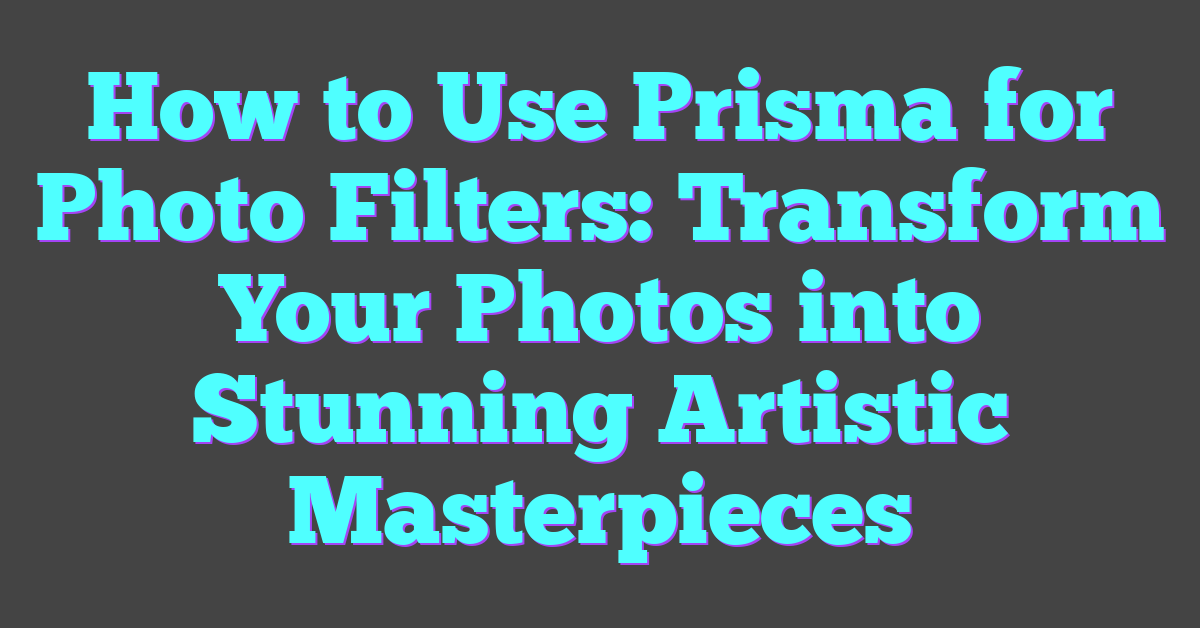I’ve always loved how a good photo filter can completely transform an image, turning an ordinary shot into something magical. That’s where Prisma comes in. It’s not just another photo editing app—it’s like having an artist in your pocket, ready to turn your pictures into stunning works of art.
What makes Prisma so exciting is how easy it is to use. Whether you’re new to photo editing or a seasoned pro, it’s designed to make your photos pop with just a few taps. From bold, vibrant filters to subtle, artistic touches, there’s something for every mood and style.
What Is Prisma?
Prisma is an AI-powered photo editing app that transforms images into artistic creations using neural networks and machine learning. It applies advanced algorithms to mimic the styles of famous artists or distinctive visual techniques. Prisma goes beyond basic filters by analyzing image content and reinterpreting it, producing effects that feel handcrafted.

Developed in 2016, Prisma gained popularity for its ability to turn simple photos into artworks. Its algorithms process photos in the cloud, ensuring high-quality renderings and enabling the use of complex computations. With over 500 filters, it caters to a wide range of styles like impressionism, cubism, and modern minimalism.
Key Features Of Prisma
Prisma shines as an AI-driven app that transforms photos into captivating artistic pieces. Its features leverage neural networks and machine learning to deliver precise, engaging edits.
Artistic Filters
Prisma’s strength comes from its expansive collection of over 500 artistic filters. These filters emulate techniques from renowned art movements like impressionism, cubism, and surrealism. For instance, the “Van Gogh” filter recreates dreamy brushstrokes, while the “Picasso” filter adopts bold geometric patterns. Each filter is powered by AI to detect and adapt to intricate image textures, preserving details while transforming the aesthetic.
Photo Enhancement Tools
Prisma’s enhancement tools complement its filters by enabling users to fine-tune their images. Features include adjusting brightness, contrast, and saturation to refine colors and balance. The AI seamlessly identifies areas needing correction, ensuring edits are contextually accurate. For example, with its “Skin Tone” adjustment, natural results are automatically maintained, even with heavy artistic modifications.
User-Friendly Interface
Prisma’s interface simplifies the editing process for all expertise levels. A clean layout highlights filter previews, ensuring instant, relatable transformations. Real-time AI processing provides immediate feedback when applying edits. A swipeable before-and-after comparison feature further enhances usability, making it effortless to track changes and iterate as needed.
How To Use Prisma For Photo Filters
Prisma combines machine learning and art to transform photos into stunning visuals. Here’s how to get started and make the most of its features.
Downloading And Installing Prisma
Downloading Prisma is simple. Find the app in the App Store (iOS) or Google Play Store (Android), and tap “Install.” Once installed, open the app and sign up by linking your Google, Facebook, or Apple account or creating a new one. I appreciate how fast the setup process is, allowing users to jump into exploring artistic filters immediately.
Navigating The Interface
Prisma’s interface features an intuitive design. The home screen displays recent photos from your gallery for quick access. Use the bottom toolbar to switch between gallery imports and the camera. After selecting an image, you’ll find filters arranged in a horizontally scrollable list. For me, the simplicity of accessing and previewing filters makes it seamless when exploring artistic possibilities.
Applying Filters To Your Photos
Applying filters in Prisma uses AI to analyze your image structure and adjust it artistically. Start by selecting a photo from the gallery or using Prisma’s in-app camera. Then, scroll through the available filters and tap on one to see its effect. Filters like “Mosaic” and “Urban” showcase the app’s capability to reinterpret photos using complex AI algorithms inspired by famous art styles. It fascinates me how efficiently Prisma processes these transformations in real-time.
Customizing Filter Intensity
Adjust the filter intensity by sliding your finger horizontally across the image. Slide left to soften the effect or right to make it stand out. Prisma allows precise control over the artistic impact, making it adaptable for subtle or dramatic changes. I love this feature because it lets users experiment with AI-generated artistry without overwhelming the original composition.
Tips And Tricks For Best Results
Using Prisma to its fullest potential involves understanding its AI mechanics and artistic versatility. Here’s how to maximize Prisma’s capabilities for professional-quality photo edits.
Choosing The Right Filter
Selecting a filter depends on the image content and the mood you want to convey. Prisma’s AI algorithms analyze visual elements like colors, patterns, and textures to match them with compatible artistic styles. For landscapes, vibrant filters such as “Claude Monet” enhance natural features. Portraits often pair well with expressive styles like “Van Gogh” or “Picasso” to emphasize details and mood. I experiment with different options based on composition until I find one that aligns with the intended narrative.
Enhancing Photo Quality
Refining images before applying filters ensures polished results. Prisma includes tools for adjusting brightness, contrast, and saturation, which optimally enhance photos for AI processing. For underexposed pictures, I increase brightness to reveal hidden details. High contrast in monochrome images often improves the depth of Prisma’s AI transformations. Proper adjustments provide a balanced foundation for filters, ensuring clean, high-quality output.
Experimenting With Different Styles
Prisma’s vast library of filters offers unlimited creative opportunities. Switching between styles like impressionism, modern minimalism, and surrealism highlights how AI reinterprets diverse artistic techniques. I often explore a single photo with multiple filters to discover unique perspectives that I might overlook with just one. Since Prisma allows intensity customization, lower levels of stylization preserve photo realism, while higher intensities transform it into bold artwork. Combining experimentation with Prisma’s machine learning outputs creates visually dynamic and innovative content.
Pros And Cons Of Prisma
Prisma demonstrates how AI and machine learning can create visually stunning and expressive content. By blending artistic innovation with advanced technology, it offers users both exciting opportunities and certain constraints.
Advantages Of Using Prisma
- AI-Powered Artistic Filters
Prisma uses neural networks to recreate artistic styles, transforming photos into digital artworks inspired by artists like Van Gogh and Picasso. This application of AI simplifies art creation for users who don’t have formal artistic skills.
- Wide Selection Of Styles
With over 500 filters, Prisma caters to diverse aesthetic preferences. Users can experiment with artistic techniques ranging from surrealism to impressionism to find the perfect look for their creations.
- Customizable Filter Strength
Users can adjust the intensity of filters, providing control over the level of transformation. This flexibility enhances customization and creativity, enabling both subtle edits and dramatic, stylized effects.
- Real-Time Processing
The app processes images instantly using AI, making editing fast and accessible. Real-time results allow users to make quick decisions during photo transformations.
- Photo Enhancement Tools
Adjustments for brightness, contrast, and saturation ensure images are polished before filters are applied. With AI-guided corrections, users achieve contextually optimized photo quality effortlessly.
Limitations To Consider
- Dependency On Internet Connectivity
Prisma requires online access to process images since the AI model operates on remote servers. Photo editing may be limited in areas with poor connectivity.
- Limited High-Resolution Output
The app’s processed images occasionally have size or quality restrictions, which might not meet professional standards for large prints or commercial use.
- Subscription Model For Premium Features
While Prisma is free to use, many advanced filters and tools require a paid subscription. This could pose a challenge for users seeking comprehensive functionality without additional cost.
- Standardized Style Outputs
Though the filters are based on AI-generated artistry, they apply predefined styles. Users looking for unique, personalized designs may find the options predictable after extended use.
- Resource-Intensive Processing
On some devices, Prisma’s AI-powered editing can result in slower performance or higher battery consumption, especially when processing high-complexity images.
Conclusion
Prisma has truly redefined what’s possible with photo editing by blending technology and art in such a seamless way. Whether you’re a casual user looking to add a creative touch or someone aiming for professional-quality edits, this app offers something for everyone. Its ability to turn ordinary photos into stunning works of art is nothing short of impressive.
I love how intuitive and fun it is to experiment with Prisma’s vast collection of filters. It’s a tool that not only enhances creativity but also makes photo editing feel effortless. If you haven’t explored Prisma yet, it’s definitely worth giving it a try—you might just find your new favorite way to transform your photos!




